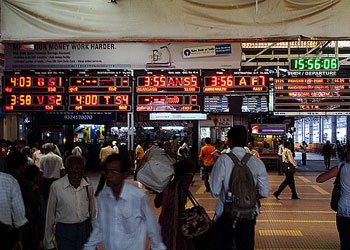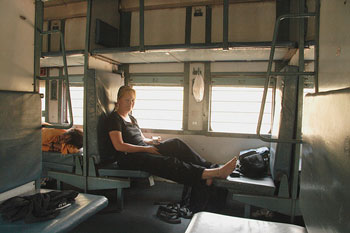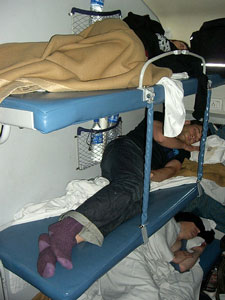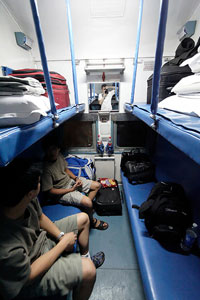
 The Indian Railway is, without a shade of doubt, the lifeline of India. It is the world’s largest railway network under a single management.
The Indian Railway is, without a shade of doubt, the lifeline of India. It is the world’s largest railway network under a single management.
From a traveler’s point of view, train travel opens up a window through which you can see India in a unique perspective.
However, with nearly 62,000 km of rail, 7,500 stations and 7,800 locomotives, traveling by the Indian Railway can be a daunting task. Fortunately, what you are about to read will make things a whole lot simpler.
In the order of decreasing price and comfort we have the 1st AC, 2nd AC, First Class (Non-AC), 3rd AC, Sleeper Class and Unreserved Class. For the common traveler, I would recommend Sleeper Class travel. If money is not a constraint, and you like to have a little privacy First Class travel is a good option.
1st AC – Air-conditioned compartments with 2 or 4 bunks and a wash basin, including all bedding. It’s fancier than you would probably imagine, and quite expensive as well.

 2nd AC – Air-conditioned compartments with 4 bunks and not as fancy, but still very nice, and about half the price of 1st AC.
2nd AC – Air-conditioned compartments with 4 bunks and not as fancy, but still very nice, and about half the price of 1st AC.
1st Class (non-AC) – Similar to 1st Class AC above, but without bedding or air-conditioning, and much cheaper if you can find it.
3rd AC – Air-conditioned compartments with 6 bunks per compartment so it’s more crowded but still comfortable and clean, and quite cheap usually.
Sleeper Class – This is similar to 3rd AC but without air-conditioning or bedding, and usually quite crowded.
Unreserved 2nd Class – Open carriages with bench seats and often amazingly crowded, and extremely cheap, of course.

 Special Tip: If you want to see the “real” India, please do not travel in AC compartments because:
Special Tip: If you want to see the “real” India, please do not travel in AC compartments because:
That said, 3rd AC travel is recommended under the following circumstances:
The following classes are a strict no from a tourist’s point of view:
Apart from the above classes, you will also have AC Chair Car – compartments with reclining chairs. I recommend them for short trips lasting no longer than 4 to 5 hrs.
Getting reservations is the main problem when it comes to traveling in India, and things can get especially bad during festive seasons. Therefore, you need to plan and research your trip. India is not a place where you can waltz in thinking “We’ll see when we get there.” Half the battle is won if you have dates – solid dates.
I know what you are thinking – fixing dates reduces flexibility. Well it does – only if you do not know about the following features:
Break Journey

 If you book a single journey ticket for a distance more than 500 km, you can break the journey once for a period of two days at any station en-route after 500km. The two days do not include the day of arrival and day of departure. If you plan your journey well you can spend up to 4 days at any destination en-route. This will give you enough time to cover all the tourist destinations in and around the city where you break your journey. This will give your tremendous flexibility. Read more about this facility here.
If you book a single journey ticket for a distance more than 500 km, you can break the journey once for a period of two days at any station en-route after 500km. The two days do not include the day of arrival and day of departure. If you plan your journey well you can spend up to 4 days at any destination en-route. This will give you enough time to cover all the tourist destinations in and around the city where you break your journey. This will give your tremendous flexibility. Read more about this facility here.
Circular Journey
If you wish to cover many destinations in a single trip, you can book a circular journey ticket such that the journey begins and ends at the same station. A single circular journey ticket permits 8 breaks in between. Indian Railway has some standard circular journey routes covering most of the popular tourist destinations across India. You can either purchase the tickets for planned routes or plan the route yourself.
Circular journey offers the following advantages:
For booking procedure, standard circular journey routes and fares for standard circular journey routes go and register yourself.
It is that easy.
Note: This is the best way to reserve your journey tickets provided you plan in advance.
Every major hotel has a tourist cell, which can help you obtain reservations. You might have to pay a little extra but these people know how to pull the strings and get the job done. The convenience of it all is what makes this option worth the while. You can talk to the receptionist about future travel plans (remember to tell them the 3 Ds – Date, Destination and Departure time) and ask them to make reservations for you. However, you have to be reasonable so give them at least a two-day notice. You can collect the ticket from the reception or ask them to have it delivered to your room.
As a true Indian I must not say this, but I am saying it anyway (it does not mean I am not a true Indian; I just care about my fellow travel enthusiasts).
Well, you can usually get a seat if you have a crispy hundred rupees note handy to “tip” the Train Ticket Examiner. With some smooth talking and a generous bribe *cough* you can manage yourself a seat 90% of the time. I have done it many times (and I am not proud of it); mostly when my boss tells me “You have to go to New Delhi by the first train available.”
If anybody asks – you did not hear this from me.
Traveling by train is not as dreaded as some of you might think. You just need a little foresight and prepare accordingly.